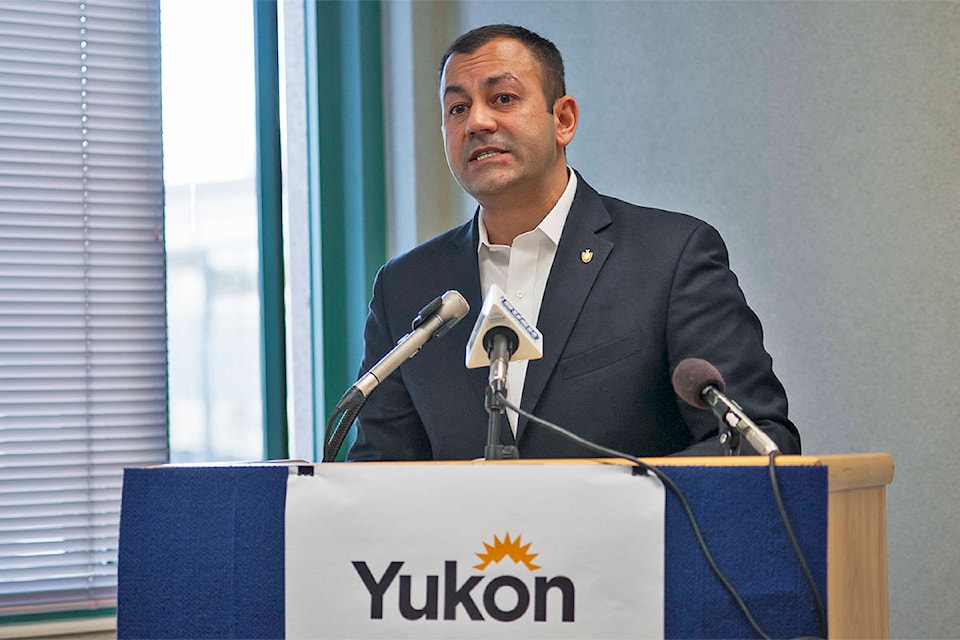Independent, renewable energy producers, both large and small, are now able to sell electricity they generate to Yukon utilities.
The territorial government unveiled its implemented policy on Jan. 25, the benefits of which are two pronged, said Ranj Pillai, minister of the Department of Energy, Mines and Resources. It will increase the amount of energy available in the Yukon and the power will come from clean, “affordable” sources including hydro, solar, geo-thermal, wind and biomass.
“The policy promotes a secure and sustainable energy future for the Yukon and supports the development of local energy infrastructure,” Pillai said.
In May 2014, the Yukon Party received some flak for including natural gas in a draft policy.
Thermal generation was omitted from the strategy in 2018. Diesel and natural gas are specifically used in the Yukon.
“At the door during our election, we heard over and over again from Yukoners that they felt that they wanted to see a cleaner future,” Pillai said. “That’s why the decision was made.”
The policy permits residents and businesses to generate their electricity, while receiving “some compensation” from the Yukon Energy Corporation and, or ATCO Electric Yukon for excess power produced.
Independent power producers (IPPs) will earn roughly 16 cents per kilowatt-hour of electricity as a starting price. This cost reflects displaced diesel and natural gas that isn’t used to generate electricity.
On an annual basis, the price paid for new electricity will increase at the rate of half the consumer price index (CPI) for on-grid projects. For communities that rely on diesel prices would be increased at full CPI.
In the Yukon, projects that produce 50 kilowatts are considered micro-generation systems. Projects that produce between 30 and 2,000 kilowatts or more can choose to be considered IPPs.
There are 225 micro-generation systems installed in the territory, Pillai said.
“This makes Yukon a leader in the field, with some of the highest renewable energy generating systems installed in Canada. We want to build on this because we know we can do more,” he said.
According to the IPP policy itself, “10 per cent of new electrical demand (is) to be met by IPP.” Further, at least 50 per cent of these projects must involve First Nations enterprises.
Shoo-ins for gaining IPP status include the Vuntut Gwitchin First Nation’s solar project in Old Crow and Kluane First Nation’s wind project in Destruction Bay.
One reason behind why these projects are working well in smaller communities is because First Nations are accessing federal grants, said Jay Massie, manager at ATCO Electric Yukon.
“That definitely helps with the upfront capital and makes these projects able to fit into existing rates,” he said.
Six months ago, there was no way for independent producers to sell electricity, said Shane Andre, the director of the Department of Energy, Mines and Resources’ energy branch, which lead the development, implementation of the policy.
A new regulation was developed to define what independent producers are, differentiating them from public utilities.
“ATCO and Yukon Energy were the only two (utilities),” Andre said.
“This is empowering the private sector to help meet this demand,” he continued. “It’s not just looking to Yukon Energy to do it all. We know that there are great projects that First Nations and other communities might have, might want to develop, so why hold them back if they have a good idea and it works.”
There are three categories that IPPs can fall under depending on the amount of power they hope to produce, each with different guidelines.
The standing offer program caters to small-scale power producers connected to the Yukon’s main electricity grids. Projects that are capable of producing between 30 and 2,000 kWs in order to be eligible.
There are system-wide limits on generation – 20,000 megawatt hours on an annual basis for the Yukon system, which include the Whitehorse-Aishihik-Faro and Mayo-Dawson grids; 2,100 MW hours per year for Watson Lake, the policy says.
“IPPs will be responsible for interconnection costs and necessary interconnection upgrades, as well as maintenance of their infrastructure,” according to the policy.
The second category, a call for power, entails utilities looking for larger projects that produce more than 20,000 MWs. They require the seal of government.
“We’d make a recommendation as to whether or not we felt the project was appropriate to proceed, at which point the utilities would go through the assessment process,” Andre said.
“I don’t have any examples because we’re not planning any calls for power at the moment,” he continued, adding that there’s no size limit. “It’s a tool we could take advantage of in the future.”
The third component of the policy concerns what it refers to as unsolicited proposals, which involve projects that have a larger energy output than the maximum annual cap of 20,000 MWs for standing offer programs, or ones found in remote, diesel-powered communities like Old Crow or Beaver Creek.
These proposals can be submitted to the utilities or the Yukon government’s energy branch at any time, the policy says.
The policy would be reviewed bi-annually from the day it’s effective.
Asked if new IPP projects will be more expensive, Andre said: “The analysis we’ve looked at, it’s pretty insignificant. The caps are small so the impacts would be quite small. Yukoners’ bills will always be affected by any new project.”
Contact Julien Gignac at julien.gignac@yukon-news.com
Correction: This story has been updated to accurately reflect increased prices for new electricity.
